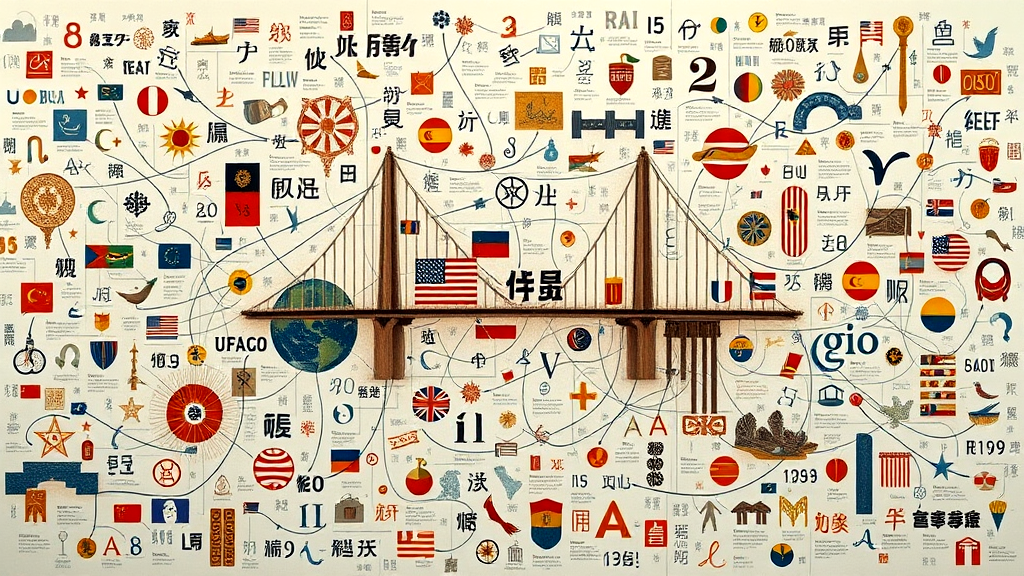Navigating English-Viet Translation Hurdles
Have you ever tried translating between English and Vietnamese? It’s like a linguistic tightrope walk. I often find myself navigating the unique challenges of this task. English and Vietnamese are worlds apart, with different structures and expressions. Even an innocent idiom can throw a wrench in the works.
I remember one time, I translated “piece of cake” literally. My Vietnamese friend thought I was hungry! So, I learned idioms need careful handling. It’s not just about words; it’s about culture. Understanding both cultures helps me connect ideas seamlessly.
Whether it’s getting the tone right or ensuring accuracy, translation demands creativity and precision. Let’s explore how to tackle these challenges together.
Key Takeaways
-
Translating English to Vietnamese is like walking a linguistic tightrope. It’s challenging.
-
Idioms can cause confusion. “Piece of cake” isn’t always about dessert!
-
Cultural understanding is crucial. It helps connect ideas seamlessly between languages.
-
Accurate tone and style are key. Both require creativity and precision.
-
Effective translation involves understanding linguistic structures and the context of each language.

Strategies for Overcoming Common Translation Challenges
Approaching the topic of overcoming translation hurdles, I realize that each challenge carries a unique set of obstacles. With English-Viet translation, many issues stem from differences in syntax and sentence structure. One trick up my sleeve is using translation memory tools. These nifty gadgets help keep things consistent. They offer a sort of “memory” for past translations, ensuring I don’t reinvent the wheel with each new project. It saves time and minimizes errors.
Now, let’s chat about context. It’s like the invisible thread holding a tapestry together. Without it, everything unravels. When I translate, I don’t just convert words. I dive into the deeper meaning. This means understanding the original message and ensuring it fits the new language setting. It’s like fitting a puzzle piece into a new puzzle. The piece might need a bit of trimming, but once it fits, it’s seamless and beautiful.
But oh, the irony of idioms! They are the jokers of language. The way idiomatic expressions twist and turn meanings can be both amusing and frustrating. Imagine trying to translate “kick the bucket” literally! That’s where creativity comes in handy. I enjoy finding equivalent expressions that tickle the same funny bone or convey the same gravity. Sometimes, a little rephrasing does the trick. Other times, a completely new approach is necessary.
Another hiccup I often face is tone. Picture this: you’re reading a heartfelt letter, but it sounds robotic. That’s what happens when tone is lost in translation. Striking the right chord involves analyzing the original text’s vibe. I consult style guides and, when in doubt, I have a chat with native speakers. Their insights are invaluable, offering a glimpse into the emotional and formal nuances that might otherwise slip through the cracks.
A sprinkle of cultural awareness can transform a bland translation into an engaging narrative. I immerse myself in both the source and target cultures. This means understanding customs, traditions, and idioms. The goal is to not just translate words, but to convey the essence of the message. It’s akin to adding a local flavor to a universal dish, making it both relatable and authentic for the audience.
To wrap things up, I find that peer review is my safety net. After the final full stop, I pass the baton to a fresh pair of eyes. It’s amazing how a different perspective can catch what I might have missed. A thorough review ensures the translation is polished and ready for the world stage.
Translation Hurdles and Solutions
|
Challenge |
Solution |
Tool Used |
Benefit |
|---|---|---|---|
|
Syntax Differences |
Use translation memory |
CAT tools |
Consistency |
|
Maintaining Tone |
Consult style guides |
Native speaker input |
Emotional connection |
|
Idiomatic Expressions |
Creative rephrasing |
Idiom dictionaries |
Accurate message conveyance |
|
Cultural Nuances |
Research and immersion |
Cultural references |
Relatability |
-
Use translation memory tools for consistency.
-
Understand the context to keep the message intact.
-
Get creative with idiomatic expressions.
-
Analyze the tone and consult style guides.
-
Immerse in cultural nuances for authenticity.
-
Engage native speakers for deeper insights.
-
Conduct thorough peer reviews for accuracy.

Utilizing Cultural Nuances in English-Viet Translation
Drawing from the idea of engaging cultural nuances for English-Viet translation, I find that immersing myself deeply in both cultures significantly improves translation quality. I don’t just translate words; I bring the vibrance of Vietnamese culture and the subtle elegance of English to life. It’s like being a cultural ambassador, ensuring each translated piece resonates with authenticity and relevance.
Incorporating cultural elements isn’t merely about avoiding direct translations. It’s about understanding the emotions, values, and unspoken rules that both languages carry. I love spotting those invisible threads that connect language to culture. For instance, translating a formal English greeting into Vietnamese might require a touch of warmth and respect, reflecting local customs.
It helps to think of translation as crafting a bridge that doesn’t just connect two shores but celebrates the beauty on each side. I sometimes picture myself as a detective, unraveling the hidden cultural clues that make a conversation tick. It’s exciting and rewarding, even if it means taking a step back and revisiting cultural contexts.
I always aim to capture the soul of the message. This often means diving into the nuances of Vietnamese proverbs and idioms. I find joy in experimenting with phrasing until I hit that perfect note that sings true to both languages. My approach is like mixing paints on a palette, blending hues until the picture feels just right.
Cultural adaptation goes beyond replacing words; it includes adjusting to the local mindset. When translating marketing materials, for instance, understanding local buying habits and preferences can make all the difference. It’s a dance between accuracy and cultural empathy.
Humor is another tricky yet fascinating aspect. What tickles the funny bone in one culture might fall flat in another. I find myself playing with words, sometimes crafting entirely new jokes that maintain the original humor’s spirit. It’s a creative process, almost like writing a new punchline for a classic joke.
I make it a point to consult with native speakers who can provide insights that books or online resources may miss. Their stories and perspectives enrich my translations, adding layers of depth and authenticity. These conversations often reveal cultural nuances that textbooks don’t cover.
Working on translations that involve cultural elements feels like painting a mural with vibrant colors, each stroke representing a piece of the culture. I revel in the challenge of finding just the right balance, ensuring that the final piece is both accurate and culturally resonant.
I believe in the power of storytelling to convey complex cultural ideas. When translating, I like to think of myself as a storyteller, weaving narratives that are both true to the original and engaging to the target audience.
Cultural references can be like hidden treasures in a text. Uncovering them requires curiosity and sensitivity. I enjoy the process, much like a treasure hunt, where each find enriches the final piece.
Maintaining cultural authenticity is about seeing beyond words and capturing the essence of a message. I strive to ensure that each translation is more than mere words on a page; it’s a reflection of cultural identity and shared human experience.
|
Aspect |
English |
Vietnamese |
Cultural Nuance |
|---|---|---|---|
|
Greetings |
Formal and polite |
Warm and respectful |
Reflects hierarchical respect |
|
Humor |
Sarcastic and dry |
Playful and witty |
Adapts to local humor styles |
|
Idiomatic Expressions |
Literal |
Metaphorical |
Requires cultural context |
|
Marketing Language |
Direct |
Indirect |
Aligns with local buying habits |
|
Proverbs |
Concise |
Poetic |
Reveals cultural values |

Adapting Idiomatic Expressions for Accurate Translation
The art of translating idioms requires a creative approach where expressions are transformed seamlessly. In English Vietnamese translation, idioms often don’t have direct equivalents. It’s like trying to fit a square peg in a round hole. Translators must play linguistic detectives, finding or inventing suitable Vietnamese phrases. This ensures the expression’s essence remains intact.
I’ve discovered that humor can be a tricky element to translate. Vietnamese humor is often subtle and reliant on wordplay. It’s like telling a joke in a room where no one speaks your language. The punchline can easily be lost in translation. I usually find alternative expressions that elicit the same chuckle or raise a similar eyebrow.
In English Vietnamese translation, cultural insights are my best ally. Idioms are deeply rooted in culture; they carry historical and social nuances. For instance, the English idiom “break the ice” isn’t about literal ice in Vietnamese culture. I’d look for a similar Vietnamese idiom or describe the action creatively. It’s all about finding that cultural bridge.
To tackle idioms effectively, I rely on resources like bilingual dictionaries. But, I also trust my cultural experiences and exposure. When I hit a roadblock, I consult with native speakers. Their insights are gold mines of cultural context that I can’t find in any book. Sometimes, it’s like a treasure hunt, and the prize is a perfectly translated idiom.
When faced with idiomatic challenges, I follow a methodical process. First, I decipher the idiom’s underlying meaning. Next, I explore Vietnamese expressions that convey a similar sentiment. If none exist, I consider rewording the message while preserving its intent. It’s a fascinating puzzle, one that keeps my brain sharp and my spirit engaged.
Here’s a table that can help illustrate common idiomatic translation challenges:
|
English Idiom |
Literal Vietnamese Translation |
Cultural Equivalent |
Notes on Usage |
|---|---|---|---|
|
Break the ice |
Phá băng |
Làm quen ban đầu |
Used in social settings |
|
Hit the sack |
Đánh cái bao tải |
Đi ngủ |
Informal; bedtime context |
|
Bite the bullet |
Cắn viên đạn |
Chịu đựng điều khó |
Used to describe enduring pain |
|
Spill the beans |
Tràn đậu |
Lộ bí mật |
Used when revealing secrets |
|
Under the weather |
Dưới thời tiết |
Không khỏe |
Describes feeling unwell |
Here are some of my strategies for adapting idioms:
-
Identify the idiom’s core meaning.
-
Search for Vietnamese phrases with similar meanings.
-
Check cultural relevance with native speakers.
-
Use creative rewording if no equivalent exists.
-
Maintain the original tone and context.
-
Test translations with diverse audiences for feedback.
-
Keep updating my knowledge of evolving languages.
-
Stay curious and learn from every project.
Translation is not just about words; it’s a bridge between cultures. It’s about crafting messages that resonate equally in both English and Vietnamese. I find joy in these challenges and cherish the moments when everything clicks.
Each idiom conquered feels like a small victory, a testament to the translator’s skill and cultural understanding. Language is alive, dynamic, and ever-changing. It’s a journey I’m thrilled to be part of, one idiom at a time.

Ensuring Accurate Tone and Style in Translation
To secure a faithful tone and style in translations, especially in English-Viet contexts, I delve into the heart of the source material. It’s not just about the words but the emotions and intentions behind them. Think of it like painting a picture with words; every brushstroke must match the original artwork. I rely on style guides and tone indicators to stay on the right path, but it’s the collaboration with native speakers that often seals the deal. They can provide insights into cultural subtleties that a guide simply can’t offer.
Working with native speakers isn’t just a safety net, it’s a goldmine of authentic feedback. They can sense when something feels off, like a musician hearing a wrong note in a symphony. Their input helps me tweak translations until they sound just right in Vietnamese. The goal is to make the reader feel the message as deeply as they would in English.
When tackling English-Viet translations, I also pay close attention to who the audience is. Different audiences can require different tones, even for the same text. A business document might need a formal tone, while a marketing piece might need a more engaging approach. Style guides help keep this in check, but intuition plays a big role too. Sometimes, you just have to trust your gut.
A unique challenge is maintaining humor or emotional tone in translations. Jokes and expressions often rely heavily on cultural context. It’s not enough to translate words; the humor must land in Vietnamese just as naturally. This might mean rephrasing or even changing the joke while keeping the spirit alive. It’s a bit like jazz improvisation—staying true to the melody while adding your own flair.
To help navigate these challenges, I keep a record of successful translation strategies. These serve as a personal playbook I can turn to when in a pinch. It’s a growing collection of tricks and techniques that have worked in the past, tailored to English-Viet translations.
Translators often face the daunting task of keeping translations consistent, especially in larger projects. Here, translation memory tools can be a lifesaver. They store previously translated sections for reuse, ensuring that terms and phrases remain consistent across different parts of the project.
But at the end of the day, translation is an art, not just a science. It’s about breathing life into text and making it sing in a new language. Every project is a chance to learn something new, to explore different facets of language and culture. And who knows, maybe one day I’ll even dream in Vietnamese!
|
Aspect |
English Vietnamese Translation |
Key Consideration |
Importance Level |
|---|---|---|---|
|
Tone |
Emotional alignment |
Analyze source text |
High |
|
Style |
Appropriate language use |
Audience analysis |
High |
|
Consistency |
Uniformity across documents |
Use translation memory |
Medium |
|
Cultural Sensitivity |
Cultural nuances |
Collaborate with natives |
High |
-
Analyze the purpose of the source text.
-
Use style guides to maintain consistent tone.
-
Collaborate with native Vietnamese speakers.
-
Adjust humor and emotional tone for cultural context.
-
Keep a personal record of successful strategies.
-
Employ translation memory tools for consistency.
-
Trust intuition alongside data-driven tools.
-
Continually learn and adapt to new challenges.
Conclusion
Translation between English and Vietnamese isn’t a walk in the park. It’s like solving a complex puzzle where every piece must fit perfectly. I find that understanding both languages deeply is key. But let’s not forget the role of cultural nuances. They’re the unsung heroes in making translations feel authentic.
Idiomatic expressions? They’re the tricky parts of the puzzle. Each one needs a creative twist to convey the same meaning in a different language. Tone and style? They’re like the icing on the cake. They ensure the translation feels right to the reader. Achieving this balance is a rewarding journey. It’s not just about words; it’s about crafting an experience that speaks to the heart.
FAQ
-
What are the main challenges in English-Viet translation?
English-Viet translation can be tricky. One big challenge is the difference in linguistic structures. Vietnamese and English have unique grammar and syntax. Another hurdle is ensuring the translation captures the right tone and style. It’s not just about words, but also the emotion and intent behind them.
-
How can I improve my English-Viet translation skills?
I’d suggest focusing on understanding both languages deeply. Use translation tools like glossaries and memory tools to maintain consistency. Don’t skip proofreading and peer reviews; they help catch errors. Immerse yourself in both cultures to grasp subtle nuances and cultural references.
-
Why are cultural nuances important in translation?
Cultural nuances are key for authenticity. They ensure the translation feels natural and relatable. Understanding local customs and traditions can make or break a translation. It’s more than just words; it’s about aligning with societal norms and expectations.
-
How do I translate idiomatic expressions accurately?
Idiomatic expressions don’t always have direct translations. It’s important to understand the meaning and intent behind them. Sometimes you need to find equivalent expressions or rephrase. Creativity and cultural insight play a big role here.
-
What’s the best way to ensure the right tone and style in translation?
First, analyze the source text’s purpose and audience. Use style guides and tone indicators to align with the desired emotional and formal aspects. Collaboration with native speakers can be invaluable. They can provide insights to ensure the translation resonates with the target audience.




